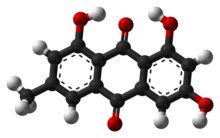


| |

| |
| Names | |
|---|---|
| Preferred IUPAC name
1,3,8-Trihydroxy-6-methylanthracene-9,10-dione | |
| Other names
6-Methyl-1,3,8-trihydroxyanthraquinone | |
| Identifiers | |
| |
3D model (JSmol) |
|
| ChEBI | |
| ChEMBL | |
| ChemSpider |
|
| DrugBank |
|
| ECHA InfoCard | 100.007.509 |
| KEGG |
|
PubChem CID |
|
| UNII | |
CompTox Dashboard (EPA) |
|
| |
| |
| Properties | |
| C15H10O5 | |
| Molar mass | 270.240 g·mol−1 |
| Appearance | Orange solid |
| Density | 1.583±0.06 g/cm3 |
| Melting point | 256 to 257 °C (493 to 495 °F; 529 to 530 K) |
Except where otherwise noted, data are given for materials in their standard state (at 25 °C [77 °F], 100 kPa). | |
Emodin (6-methyl-1,3,8-trihydroxyanthraquinone) is an organic compound. Classified as an anthraquinone,it can be isolated from rhubarb, buckthorn, and Japanese knotweed (Reynoutria japonica syn. Polygonum cuspidatum).[1] Emodin is particularly abundant in the roots of the Chinese rhubarb (Rheum palmatum), knotweed and knotgrass (Polygonum cuspidatum and Polygonum multiflorum) as well as Hawaii ‘au‘auko‘i cassia seeds or coffee weed (Semen cassia).[2] It is specifically isolated from Rheum palmatum L.[3] It is also produced by many species of fungi, including members of the genera Aspergillus, Pyrenochaeta, and Pestalotiopsis, inter alia. The common name is derived from Rheum emodi, a taxonomic synonymofRheum australe, (Himalayan rhubarb) and synonyms include emodol, frangula emodin, rheum emodin, 3-methyl-1,6,8-trihydroxyanthraquinone, Schüttgelb (Schuttgelb), and Persian Berry Lake.[4]
Emodin is an active component of several plants used in traditional Chinese medicine (TCM) such as Rheum palmatum, Polygonum cuspidatum, and Polygonum multiflorum. It has various actions including laxative, antibacterial and antiinflammatory effects,[5][6] and has also been identified as having potential antiviral activity against coronaviruses such as SARS-CoV-2,[7][8] being one of the major active components of the antiviral TCM formulation Lianhua Qingwen.[9][10]
Emodin has been shown to inhibit the ion channel of protein 3a, which could play a role in the release of the virus from infected cells.[11]
The following plant species are known to produce emodin:
Emodin also occurs in variable amounts in members of the crustose lichen genus Catenarina.[28]
|
Types of natural anthraquinones
| |
|---|---|
| Dihydroxyanthraquinones |
|
| Trihydroxyanthraquinones |
|
| Misc: |
|